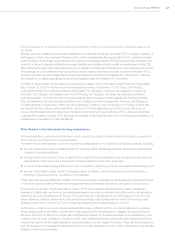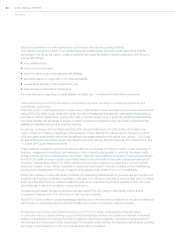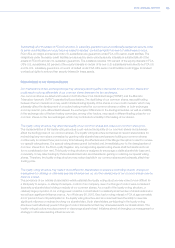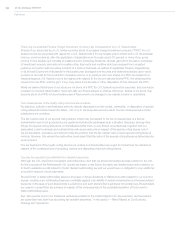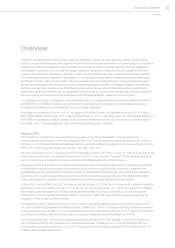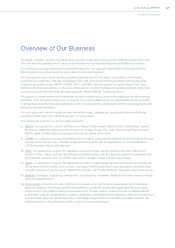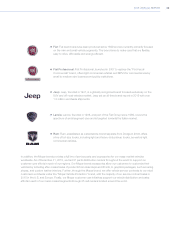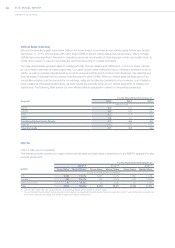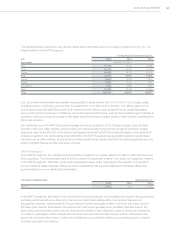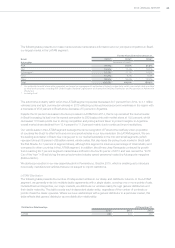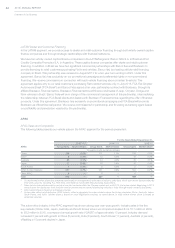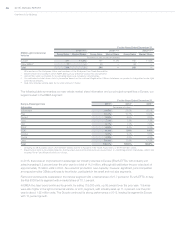Chrysler 2015 Annual Report Download - page 36
Download and view the complete annual report
Please find page 36 of the 2015 Chrysler annual report below. You can navigate through the pages in the report by either clicking on the pages listed below, or by using the keyword search tool below to find specific information within the annual report.
36 2015 | ANNUAL REPORT
Industry Overview
The automotive industry is highly competitive, especially in our key markets, such as the U.S., Brazil, China and
Europe. Vehicle manufacturers must continuously improve vehicle design, performance and content to meet
consumer demands for quality, reliability, safety, fuel efficiency, comfort, driving experience and style. Historically,
manufacturers relied heavily upon dealer, retail and fleet incentives, including cash rebates, option package discounts,
guaranteed depreciation programs, and subsidized or subvented financing or leasing programs to compete for vehicle
sales. Since 2009, manufacturers generally have worked to maintain a reduced reliance on pricing-related incentives
as competitive tools in the North American market, while pricing pressure, under different forms, is still affecting sales
in the European market since the inception of the financial crisis. However, an OEM’s ability to increase or maintain
vehicle prices and reduce reliance on incentives is limited by the competitive pressures resulting from the variety of
available competitive vehicles in each segment of the new vehicle market as well as continued global manufacturing
overcapacity in the automotive industry. At the same time, OEMs generally cannot effectively lower prices as a
means to increase vehicle sales without adversely affecting profitability, since the ability to reduce costs is limited by
commodity market prices, contract terms with suppliers, evolving regulatory requirements and collective bargaining
agreements and other factors that limit the ability to reduce labor expenses. Due to the capital intensive nature of our
industry, we expect there will be greater levels of cooperation among automakers in the future.
OEMs generally sell vehicles to dealers and distributors, which then resell vehicles to retail and fleet customers. Retail
customers purchase vehicles directly from dealers, while fleet customers purchase vehicles from dealers or directly from
OEMs. Fleet sales comprise three primary channels: (i)daily rental, (ii)commercial and (iii)government. Vehicle sales in
the daily rental and government channels are extremely competitive and often require significant discounts. Fleet sales
are an important source of revenue and can also be an effective means for marketing vehicles. Fleet orders can also help
normalize plant production as they typically involve the delivery of a large, pre-determined quantity of vehicles over several
months. Fleet sales are also a source of aftermarket service parts revenue for OEMs and service revenue for dealers.
Financial Services
Because dealers and retail customers finance the purchase of a significant percentage of the vehicles sold worldwide,
the availability and cost of financing is one of the most significant factors affecting vehicle sales volumes. Most dealers
use wholesale or inventory financing arrangements to purchase vehicles from OEMs in order to maintain necessary
vehicle inventory levels. Financial services companies may also provide working capital and real estate loans to
facilitate investment in expansion or restructuring of the dealers’ premises. Financing may take various forms based on
the nature of creditor protection provided under local law, but financial institutions tend to focus on maximizing credit
protection on any financing originated in conjunction with a vehicle sale. Financing to retail customers takes a number
of forms, including simple installment loans and finance leases. These financial products are usually distributed directly
by the dealer and have a typical duration of three to five years. OEMs often use retail financing as a promotional tool,
including through campaigns offering below market rate financing known as subvention programs. In such situations,
an OEM typically compensates the financial services company up front for the difference between the financial return
expected under standard market rates and the rates offered to the customer within the promotional campaign.
Many automakers rely on wholly-owned or controlled finance companies to provide this financing. In other situations,
OEMs have relied on joint ventures or commercial relationships with banks and other financial institutions in order to
provide access to financing for dealers and retail customers. The model adopted by any particular OEM in a particular
market depends upon, among other factors, its sales volumes and the availability of stable and cost-effective funding
sources in that market, as well as regulatory requirements.
Financial services companies controlled by OEMs typically receive funding from the OEM’s central treasury or from
industrial and commercial operations of the OEM that have excess liquidity, however, they also access other forms
of funding available from the banking system in each market, including sales or securitization of receivables either in
negotiated sales or through securitization programs. Financial services companies controlled by OEMs compete primarily
with banks, independent financial services companies and other financial institutions that offer financing to dealers and
retail customers. The long-term profitability of finance companies also depends on the cyclical nature of the industry,
interest rate volatility and the ability to access funding on competitive terms and to manage risks with particular reference
to credit risks. OEMs within their global strategy aimed to expand their business, may provide access to financial services
to their dealers and retail customers, for the financing of parts and accessories, as well as pre-paid service contracts.



